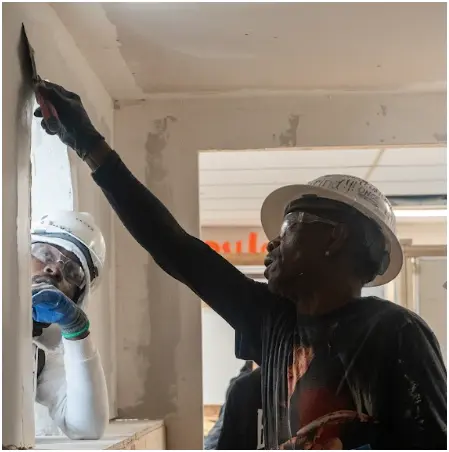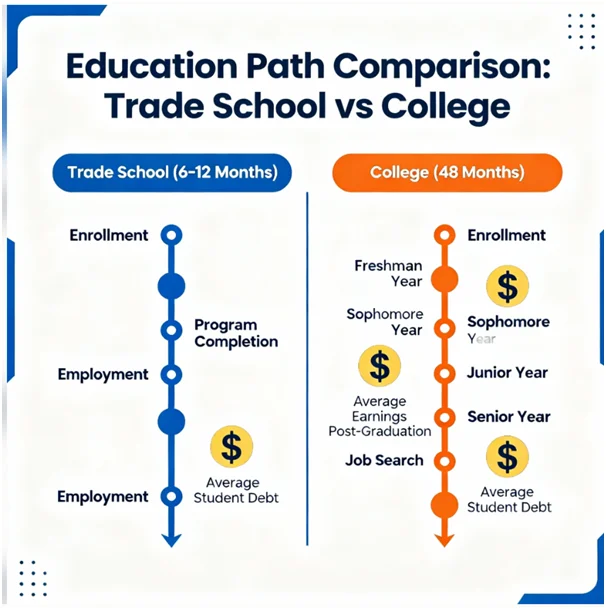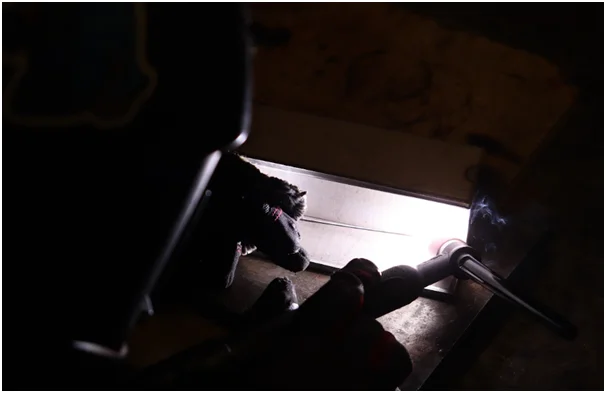Planning your future career requires understanding realistic timelines. How long is trade school, actually? Most people want clear answers before making big decisions. This guide explains everything about trade school duration in simple terms.
Trade school takes between 6 months and 2 years for most programs. Your chosen career path determines the exact timeline you’ll need. Certificate programs finish faster than associate degree options available today. However, the specific trade you select matters more than anything else.
The average trade school duration nationwide ranges from six to twenty-four months. Certificate programs last six to twelve months for basic skills. Associate degrees require eighteen to twenty-four months for advanced positions. Your schedule choice affects how quickly you complete your program.
Full-time students finish much faster than part-time learners who work simultaneously. Trade school programs provide focused training without unnecessary general education courses. Moreover, you start earning money years before traditional college graduates enter the workplace.
| Program Type | Duration Range | Best For |
| Certificate | 6-12 months | Fast career entry |
| Diploma | 12-18 months | Moderate training depth |
| Associate Degree | 18-24 months | Advanced positions |
| Accelerated Programs | 4-8 months | Career changers |
Education Data Initiative & Indeed Career Guide, 2025.
Philadelphia Technician Training Institute offers programs ranging from six to twelve months. Additionally, PTTI designs courses for working adults who need flexible schedules. Students gain hands-on skills employers actually want in today’s job market.
Plumbing trade school programs last between six months and two years total. Basic certificate programs can be completed in six to twelve months at schools nationwide.
Students learn pipe installation, repair techniques, and safety protocols during training periods. Meanwhile, you gain experience with fundamental plumbing tools and equipment every single day. Plumbing programs at trade schools prepare you for licensing exams after graduation.
Welding trade school programs typically last between six and eighteen months currently. Introductory welding courses finish in seven to ten months at most institutions. PTTI provides welding training that students complete within six to eight months.
Welding programs teach multiple techniques, including stick welding and metal arc welding. Students practice welding different metals and learn proper safety equipment usage daily. Additionally, shorter programs focus on basic skills while longer ones cover specializations.
Advanced welding training typically spans two years, providing comprehensive technical knowledge development. However, most welders start working after completing six to twelve-month programs. The welding trade school timeline depends on your career goals and specialization.

HVAC trade school programs range from six to twenty-four months for completion. Certificate programs in heating and cooling finish in eight to twelve months.
Students learn air conditioning systems, heating equipment installation, and refrigeration technology thoroughly. Moreover, hands-on practice with real HVAC equipment happens throughout the entire program. Trade schools teach troubleshooting skills employers need from day one at work.
Longer HVAC programs include additional topics like energy efficiency and advanced diagnostics. Nevertheless, most HVAC technicians begin their careers after twelve months of training. Furthermore, trade school prepares you for EPA certification exams required for employment.
Electrical trade school programs last between eight and twenty-four months, typically. Introductory electrician courses are completed in eight to twelve months at schools.
The electrician apprenticeship can take six months for fast-track certification. Students learn wiring techniques, electrical codes, and safety standards every single day. Additionally, programs include blueprint reading and troubleshooting skills employers require immediately.
Advanced electrical programs extend to two years for commercial and industrial specializations. However, entry-level electrician positions become available after eight to twelve months. Trade school electrical programs prepare students for licensing exams in their states.
Pipefitting training courses range from several months to one full year total. Programs include both classroom instruction and practical on-the-job training components. Students learn pipe installation, welding techniques, and blueprint reading skills throughout training.
Pipefitter training prepares workers for construction, manufacturing, and industrial facility careers. Moreover, apprenticeships often last two to four years after initial schooling ends. Trade schools provide the foundation skills needed before entering apprenticeship programs officially.
Sterile processing technician programs last between six and twelve months, generally. PTTI offers SPT training that students complete in six to eight months. Programs range from several months to over one year, depending entirely.
Students learn medical equipment sterilization, infection control, and surgical instrument handling daily. SPT programs offer faster healthcare career entry than nursing degree programs.

Drywall, framing, and finishing programs at PTTI last a total of 900 hours. The program includes 325 lecture hours plus 375 shop hours for practice. Additionally, students complete 200 externship hours working in real construction environments.
Construction training programs vary from several weeks to two or more years. Short-term programs last just weeks or months for basic construction skills. Long-term vocational programs extend one to two years for comprehensive training.
So if you’re eager to start working fast, it’s worth asking yourself — how long is trade school really for your dream career? Many factors influence how long trade school actually takes for different students. Understanding these elements helps you plan your educational timeline more accurately. Let’s examine what determines trade school duration in real-world scenarios today.
Full-time students complete programs much faster than part-time learners who work. Trade school duration changes based on your weekly time commitment to classes. Additionally, evening and weekend programs extend completion timelines by 50 to 100 percent.
Certificate programs finish faster than associate degree programs in every trade field. Your educational goal determines whether you need six months or two years. Moreover, prerequisite requirements can add extra time before starting your main program.
Some students enter trade school with previous experience in related fields. This prior knowledge sometimes shortens program length through credit transfers or testing. Furthermore, accelerated programs condense coursework into intensive schedules for faster completion times.
State licensing requirements affect how long training must continue for legal work. Different states mandate varying amounts of classroom hours and practical training time. Therefore, research your specific state’s requirements before choosing any particular program.
Apprenticeship components add time to some trade school programs significantly today. Combined programs integrate classroom learning with paid on-the-job training periods simultaneously. These arrangements extend overall timelines but provide valuable real-world experience early.

Trade school offers much faster completion than traditional four-year college degree programs. Let’s compare trade school timelines against college and community college options directly.
| Education Path | Average Duration | Total Cost | First Paycheck |
| Trade School | 6-12 months | $8,000-$16,000 | 8-14 months |
| Community College | 18-24 months | $15,000-$25,000 | 20-30 months |
| Four-Year University | 48 months | $80,000-$150,000 | 50-60 months |
Trade school gets you working three to four years before university graduates. Your first paycheck arrives within one year of starting trade school, usually. Meanwhile, college students accumulate debt while trade school graduates earn money already.
Trade school programs focus exclusively on job-specific skills employers need immediately today. Universities require general education courses unrelated to your actual career path. Consequently, trade school eliminates wasted time on subjects you’ll never use professionally.
Most trade programs cost about $8000 to $16,000 total. At the same time, 4-year university degrees cost around eighty thousand to one hundred fifty thousand dollars. Therefore, trade school saves you from enormous amounts of money and debt burden.
Yes, you absolutely can finish specific trade school programs in six months. Several trades offer accelerated programs designed for fast completion times, specifically today. Let’s explore which of the shortest trade school programs exist in 2025.
Accelerated trade school programs condense coursework into intensive daily schedules. Students attend classes longer each day to complete requirements faster than usual. Furthermore, accelerated options work perfectly for career changers who need quick transitions.
Sterile processing technician programs are completed in four to six months at schools. Basic welding certifications are completed within 6 months for entry-level welders starting careers. HVAC fundamentals programs are sometimes completed in six months for residential technician positions.
The shortest trade school programs focus on essential skills without advanced specializations. You learn exactly what employers need for entry-level positions in your field. Additionally, you can always return later for advanced training after working.
Six-month programs require a full-time commitment, with no simultaneous work during training periods. Students devote their full attention to learning new skills every day. Moreover, intensive programs demand strong motivation and excellent time management skills consistently.
Credit for prior learning sometimes reduces program length for experienced workers. Military veterans often receive credit that significantly shortens their required training time. Furthermore, transferable skills from previous jobs may exempt students from specific course requirements.
Many students wonder how long is trade school takes before they can start earning. Completing trade school marks the beginning of your professional career journey ahead. Understanding post-graduation timelines helps you plan financially and professionally for success. Let’s examine what happens immediately after finishing your trade school program.
Most trade school graduates enter apprenticeship positions that offer additional training. Apprenticeships typically last two to four years while you earn money. During this time, you gain experience under licensed professionals in your field.
Licensing exams become necessary before working independently in most regulated trade professions. Electricians, plumbers, and HVAC technicians must pass state licensing tests after graduation. Study time for these exams adds two to six months before working.
Job searching usually takes two to eight weeks for trade school graduates. PTTI reports a 90 percent job placement rate for graduates in Philadelphia. Furthermore, many students receive job offers before completing their final classes.
Your first paycheck arrives within two to four weeks of starting work. Trade careers provide immediate income without waiting months for employment opportunities elsewhere. Additionally, overtime opportunities often increase earnings beyond base salaries during busy seasons.
Career advancement typically happens faster in trades than in a traditional corporate career path.

Trade school programs at PTTI accommodate students with jobs and family responsibilities. Classes meet on flexible schedules, including daytime, evening, and weekend options available. Moreover, hybrid formats effectively combine online learning with hands-on shop time.
Welding programs at PTTI finish in six to eight months for certification. Plumbing training takes six months to two years, depending on your schedule. HVAC technician courses are completed in 6 to 9 months for most students.
Residential electrician training at PTTI typically finishes within one year of enrollment. The drywall, framing, and finishing program requires 900 total clock hours. Additionally, programs include externship hours working at real job sites locally.
PTTI maintains strong relationships with Philadelphia-area employers who hire graduates immediately. The 90 percent job placement rate demonstrates program effectiveness and industry connections. Furthermore, graduates often start working before finishing their final externship hours.
Program start dates occur multiple times throughout the year for student convenience. You don’t wait until the fall semester, as traditional colleges currently require. Therefore, you can begin your training whenever you’re ready to commit.
Most programs cost much less than university degrees while providing faster returns. Let’s break down typical expenses and payment options available in 2025.
Trade school tuition ranges from eight thousand to sixteen thousand dollars; the cost per month averages between one thousand and two thousand dollars. Meanwhile, university costs average over six thousand dollars per month nationwide.
Financial aid covers many trade school programs for qualified students through FAFSA. Federal grants don’t require repayment, unlike student loans that create debt burdens. Additionally, scholarships from trade organizations provide free money for specific career paths.
Payment plans let students spread costs over several months without interest charges. Many trade schools work with students who need flexible payment arrangements currently. Furthermore, some employers offer tuition reimbursement to workers seeking additional training.
Working while attending trade school helps many students offset costs today. Part-time programs are designed for students who maintain employment during training periods. Therefore, you can effectively learn new skills and earn money simultaneously.
Military veterans receive education benefits that cover trade school tuition costs completely. The GI Bill pays for vocational training at approved trade schools nationwide.
Understanding the difference between trade school and apprenticeships clarifies your career path. Both options lead to successful trading careers, but follow entirely different timelines. Let’s compare these two educational approaches side by side directly now.
Trade school provides concentrated classroom instruction plus hands-on shop practice time. Programs finish in 6 to 24 months, with a structured curriculum. You graduate with fundamental skills ready for entry-level employment opportunities immediately.
Apprenticeships combine part-time classroom learning with a daily full-time apprenticeship period while learning professionally.
Trade school graduates often enter apprenticeships after completing their initial training programs. This combination provides both technical knowledge and practical experience that employers value highly. Furthermore, trade school credits can sometimes reduce the required apprenticeship hours by 1 year.
Apprenticeships require finding an employer willing to sponsor your training period initially. This sponsor provides both employment and educational opportunities throughout your apprenticeship duration. Meanwhile, trade school accepts anyone who meets basic enrollment requirements immediately.
Some students prefer a trade school first to determine career fit before commitment. Short programs let you explore trades without multi-year obligations to employers. Additionally, classroom learning builds confidence before successfully entering competitive apprenticeship application processes.

Trade school duration depends on your chosen career and your level of experience. The Training Institute provides programs designed for adult learners with responsibilities. Flexible schedules and hands-on training effectively prepare you for real-world jobs. Moreover, PTTI’s 90 percent job placement rate consistently demonstrates program effectiveness.
Your future career begins with the decision you make right now. Trade school offers affordable, fast, and practical training for stable careers. Furthermore, you’ll earn money years before traditional college graduates enter the workplace.
Contact PTTI today to learn about program start dates and enrollment. Financial aid options make trade school accessible regardless of your current situation. Within six to twelve months, you could be earning a solid income. That’s the power trade school delivers for motivated students every day.
How long does trade school take?
Trade school takes six to twenty-four months, depending on your chosen program. Certificate programs can be completed in six to twelve months for basic skills. Associate degrees require eighteen to twenty-four months for advanced positions. Your schedule choice significantly affects completion time for any program.
Can you finish trade school in six months?
Yes, several trade programs can be completed in six months or less currently. Sterile processing technician courses at schools last 4 to 6 months. Basic welding certifications can be completed within 6 months for entry-level career positions. Accelerated programs require a full-time commitment, with no work permitted during training periods.
How long is plumbing trade school?
Plumbing trade school lasts 6 months to 2 years. Basic certificate programs last 6 to 12 months at schools. PTTI offers plumbing training that can be completed in approximately 8 months for students. Advanced programs lasting up to 2 years cover commercial and industrial specializations.
How long is welding trade school?
Welding trade school programs typically take 6 to 18 months, nationwide. Introductory courses typically finish in 7 to 10 months at most institutions. PTTI provides welding training that students complete over 6 to 8 months. Advanced welding extends to two years for comprehensive technical knowledge development.
How long is HVAC trade school?
HVAC trade school programs range from 6 to 24 months. Certificate programs for technicians take 8 to 12 months. PTTI offers HVAC training that takes approximately 6 to 9 months to complete. Longer programs include specializations in energy efficiency and advanced diagnostics.
How long is electrical trade school?
An electrical trade school usually lasts eight to twenty-four months for completion. Introductory electrician courses are completed in eight to twelve months at schools. PTTI provides residential electrician training in approximately 1 year. Advanced programs extend to two years for commercial and industrial electrical work.
How long is trade school vs college?
Trade school takes 6 to 24 months, while college takes 48 months. You graduate from trade school three to four years before university students. Trade school gets you earning money while college students accumulate debt. Certificate programs typically cost one-tenth the price of university degree programs.
What is the shortest trade school program?
The shortest trade school programs last 4 to 6 months. Sterile processing technician courses are completed in four to six months at schools. Basic welding certifications are completed within 6 months for entry-level positions. Short programs focus on essential skills without advanced specializations or certifications.
How long will it take me to start earning after trade school?
Most graduates start working within 2 to 8 weeks of finishing. Your first paycheck arrives within two to four weeks of employment. Trade careers provide immediate income without waiting months for opportunities elsewhere. PTTI consistently reports 90 percent job placement rates for Philadelphia graduates.
Do I need an apprenticeship after trade school?
Many trades require apprenticeships for licensing and advanced positions later on. Electricians and plumbers typically complete apprenticeships lasting three to four years. However, you earn money throughout the entire apprenticeship period while learning. Trade school graduates often start apprenticeships with advanced standing, saving time.
Electricians: https://www.bls.gov/ooh/construction-and-extraction/electricians.htm
Plumbers, Pipefitters, and Steamfitters: https://www.bls.gov/ooh/construction-and-extraction/plumbers-pipefitters-and-steamfitters.htm
HVAC Technicians: https://www.bls.gov/ooh/installation-maintenance-and-repair/heating-air-conditioning-and-refrigeration-mechanics-and-installers.htm
Welders: https://www.bls.gov/ooh/production/welders-cutters-solderers-and-brazers.htm
Medical Equipment Preparers (Sterile Processing Technicians): https://www.bls.gov/oes/current/oes319093.htm
Read More: